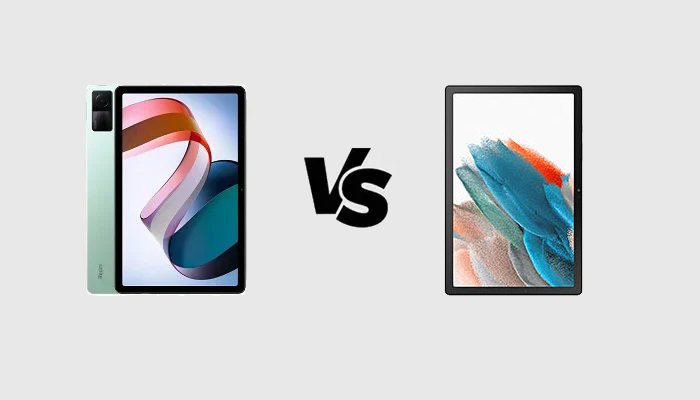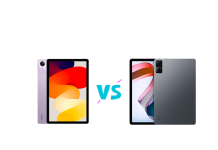If you are looking for the best tablets in terms of quality price ratio, you should definitely add the Redmi Pad to the list. This device made its debut just a bunch of weeks ago, but it is already one of the greatest tablets in the affordable segment. But is it really the best you can find in terms of quality price ratio or there are other devices with better value for money? One of the best ways to understand it is comparing it to the other affordable tablets sold in a similar price range. One of the most known ones is definitely the Samsung Galaxy Tab A8 10.5 2021, sold in the global market since the end of last year. Here you can find a comparison between the specifications of the Redmi Pad and the Samsung Galaxy Tab A8 10.5 2021.

Redmi Pad vs Samsung Galaxy Tab A8
| Xiaomi Redmi Pad | Motorola Moto Tab G62 | |
|---|---|---|
| DIMENSIONS AND WEIGHT | 250.5 x 158.1 x 7.1 mm, 465 grams | 246.8 x 161.9 x 6.9 mm, 508 g |
| DISPLAY | 10.61 inches, 1200 x 2000p (Full HD+), IPS LCD | 10.5 inches, 1200 x 1920p (Full HD+), TFT LCD |
| PROCESSOR | MediaTek Helio G99, octa-core 2.2 GHz | Unisoc Tiger T618, octa-core 2 GHz |
| MEMORY | 3 GB RAM, 64 GB – 4 GB RAM, 128 GB – 6 GB RAM, 128 GB – micro SD slot | 2 GB RAM, 32 GB – 3 GB RAM, 32 GB – 4 GB RAM, 64 GB – 3 GB RAM, 128 GB – 4 GB RAM, 128 GB – micro SD dedicated slot |
| SOFTWARE | Android 12, MIUI | Android 11, One UI |
| CONNECTIVITY | Wi-Fi 802.11 a/b/g/n/ac, Bluetooth 5.2, GPS | Wi-Fi 802.11 a/b/g/n/ac, Bluetooth 5.0, GPS |
| CAMERA | Single 8 MP f/2.0 8 MP f/2.3 front camera |
Single 8 MP 5 MP front camera |
| BATTERY | 8000 mAh, fast charging 18W | 7040 mAh, fast charging 15W |
| ADDITIONAL FEATURES | Ultrawide front camera | Optional LTE connectivity |
Design
If you read the other comparisons published on Gizmochina in the last days, you probably know that I do not like the design of the Redmi Pad very much because it has a big camera module. The Samsung Galaxy Tab A8 10.5 offers a better solution: it has a rear camera placed directly on the back cover, so the look is more minimalistic. However, I appreciate the Redmi Pad because it has an aluminum frame, while the Samsung Galaxy Tab A8 has a full plastic design. So it is inferior when it comes to the build quality. Both tablets come with a high screen to body ratio, with the display covering 80 percent of the front panel. Unfortunately, they do not have a fingerprint scanner or other advanced authentication methods, but they just come with physical keys for volume and the power key.
Display
One of the most important advantages of the Redmi Pad is the presence of a bigger display. It is a screen with a diagonal of more than 10.6 inches able to show up to one billion colors with a Full HD+ resolution of 1200 x 2000 pixels, a 90 Hz refresh rate, and a typical brightness of 400 nits. Besides coming with great color accuracy, it provides a viewing experience smoother than average thanks to the 90 Hz refresh rate. It has an IPS panel, more than sufficient for everyone in terms of image quality. The display of the Samsung Galaxy Tab A8 is decent but nothing special. We are talking about a TFT LCD panel with a diagonal of 10.5 inches and a Full HD+ resolution of 1200 x 1920 pixels. The TFT technology is actually inferior to IPS, so it does not stand a chance against the Redmi Pad. Both tablets feature four stereo speakers, so the audio department is good, and with the Samsung, you even get a 3.5 mm audio jack.
Specs & Software
The most advanced hardware setup belongs to the Redmi Pad. It is powered by the Helio G99 chipset by MediaTek, currently the best 4G mobile platform released by this chipmaker in 2022. It is a processor built with a 6 nm production process sporting an octa-core architecture composed of two Cortex A76 CPUs running at a max frequency of 2.2 GHz, six Cortex A55 CPUs running at 2 GHz, and a Mali G57 MC2 GPU. Alongside the chipset, there are up to 6 GB of RAM and up to 128 GB of native storage expandable with a micro SD. The Samsung Galaxy Tab A8 has an inferior Unisoc Tiger T618 chipset with a max frequency of 2 GHz, paired with up to 4 GB of RAM and 128 GB of internal storage in the most expensive configuration. The Redmi Pad runs Android 12 out of the box, while the Samsung is still based on Android 11. There is no challenge.
Camera
The rear cameras of the Redmi Pad and the Samsung Galaxy Tab A8 provide more or less the same quality, but the Xiaomi one features a superior front camera with an 8 MP resolution instead of just 5 MP.
Battery
Even when it comes to the battery, the Redmi Pad wins again. It has a bigger battery and a longer battery life, as well as a faster charging tech.
Price
The Samsung Galaxy Tab A8 starts from $230 or €230 (now available at much better street prices), while the Redmi Pad begins at $250 or €250. The Redmi Pad wins this comparison.
- Redmi Pad is actually available to purchase on Giztop: if you want to buy it, you can do it by clicking here
- Galaxy Tab A8 is available from AmazonIn, AmazonUS, or AmazonUK.
Xiaomi Redmi Pad vs Samsung Galaxy Tab A8: PRO and CONS
Xiaomi Redmi Pad
PRO
- Better display
- 90 Hz refresh rate
- Bigger battery
- Faster chipset
- More RAM and internal storage
CONS
- Higher price
Samsung Galaxy Tab A8 10.5 2021
PRO
- Wider availability
- More affordable
- More memory configurations
- Optional LTE connectivity
CONS
- Inferior hardware
- Smaller battery
RELATED
- Realme Pad vs Realme Pad Mini: Specs Comparison
- Huawei MatePad vs Samsung Galaxy Tab S6 Lite: more similarities than expected
- Xiaomi Pad 5 vs OPPO Pad: Specs Comparison
- Vivo Pad vs Xiaomi Pad 5: Specs Comparison
*Please Note: When you buy something using the links in our articles, we may earn a small commission at no cost to you.







